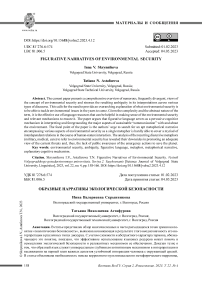Figurative narratives of environmental security
Автор: Skrynnikova I.V., Astafurova T.N.
Журнал: Вестник Волгоградского государственного университета. Серия 2: Языкознание @jvolsu-linguistics
Рубрика: Материалы и сообщения
Статья в выпуске: 4 т.22, 2023 года.
Бесплатный доступ
The current paper presents a comprehensive overview of numerous, frequently divergent, views of the concept of environmental security and stresses the resulting ambiguity in its interpretations across various types of discourse. This calls for the need to provide an overarching explanation of what environmental security is to be able to tackle environmental issues in the years to come. Given the complexity and the abstract nature of the term, it is the effective use of language resources that can be helpful in making sense of the environmental security and relevant mechanisms to ensure it. The paper argues that figurative language serves as a pervasive cognitive mechanism in interpreting and foregrounding the major aspects of sustainable “communication” with and about the environment. The focal point of the paper is the authors’ urge to search for an apt metaphorical narrative encompassing various aspects of environmental security as a single metaphor is hardly able to cover a myriad of interdependent relations in the course of human-nature interaction. The analysis of the recurring discursive metaphors (military, medical, care) to refer to environmental security has revealed their downsides in promoting an adequate view of the current threats and, thus, the lack of public awareness of the emergency actions to save the planet.
Environmental security, ambiguity, figurative language, metaphor, metaphorical narrative, explanatory cognitive mechanism
Короткий адрес: https://sciup.org/149143741
IDR: 149143741 | DOI: 10.15688/jvolsu2.2023.4.12
Список литературы Figurative narratives of environmental security
- Atamanov G.A., 2019. Ekologicheskaya bezopasnost i ee mesto v strukture bezopasnosti antropnykh system [Environmental Security and Its Place in the Structure of the Security Anthropic Systems]. Nauka XXI [The Science of the 21stCentury]. URL: http://naukaxxi.ru/ materials/173/
- Atanasova D., Koteyko N., 2017. Metaphors in Guardian Online and Mail Online Opinion-Page Content on Climate Change: War, Religion, and Politics. Environmental Communication. A Journal of Nature and Culture, vol. 11, no. 4, pp. 452-469. DOI: 10.1080/17524032. 2015.1024705
- Charteris-Black J., 2004. Corpus Approaches to Critical Metaphor Analysis. Basingstoke, Palgrave Macmillan. DOI: https://doi.org/ 10.1057/9780230000612
- Collins A., Flynn A., Munday M., Roberts A., 2007. Assessing the Environmental Consequences of Major Sporting Events: The 2003-04 FA Cup Final. Urban Studies, vol. 44, no. 3, pp. 457-476. URL: http://www.jstor.org/stable/43084354
- Collins A., 2022. Contemporary Security Studies. Oxford, Oxford University Press. 584 p.
- Dalby S., 2002. Environmental Security. University of Minnesota Press, vol. 20. 276 p.
- Ebenreck S., 1996. Opening Pandora's Box: The Role of Imagination in Environmental Ethics. Environmental Ethics, vol. 18, no.1, pp. 3-18.
- Environmental Security: Dimensions and Priorities, 2018. A STAP Document, June. URL: https:// www.stapgef.org/sites/default/files/2021-02/ 52103%20STAP% 20Report_WEB.pdf
- Flusberg S.J., Matlock T., Thibodeau P.H., 2017. Metaphors for the War (or Race) Against Climate Change. Environmental Communication, vol. 11, no. 6, pp. 769-783. URL: https://doi.org/ 10.1080/17524032.2017. 1289111
- Flusberg S., Matlock T., Thibodeau P.H., 2018. War Metaphors in Public Discourse. Metaphor and Symbol, vol. 33, no. 1. 33, pp. 1-18. DOI: 10.1080/ 10926488.2018.1407992
- Goatly A., 2007. Washing the Brain: Metaphor and Hidden Ideology. John Benjamins Publishing Company. URL: https://doi.org/10.1075/ dapsac.23
- Hammond M., Holland A., 1995. Ecosystem Health: Some Prognostications. Environmental Values, vol. 4, no. 4, pp. 283-286. URL: http:// www.jstor.org/stable/30301557
- Harris J.J., Hobbs R.J., 2001. Clinical Practice for Ecosystem Health: The Role of Ecological Restoration. Ecosystem Health, vol. 7, no. 4, pp. 195-202.
- Institute of Environmental Security Official Website. URL: https://www.envirosecurity.org/
- Jakovljevic M., Bjedov S., Jaksic N., Jakovljevic I., 2020. COVID-19 Pandemia and Public and Global Mental Health from the Perspective of Global Health Security. Psychiatr Danub. Spring, vol. 32, no. 1, pp. 6-14. DOI: 10.24869/psyd. 2020.6. PMID: 32303023
- Kaplan R.D, 2000. Coming Anarchy: Shattering the Dreams of the Post-Cold War. Random House, Inc. 198 p.
- Klein N., 2014. This Changes Everything: Capitalism vs. the Climate. New York, Simon & Schuster. 566 p.
- Linkola P.K., 1971. Dreams of a Better World. URL: https://alchetron.com/Pentti-Linkola
- Ludwig D., 2001. The Era of Management Is Over. Ecosystems, vol. 4, no. 8, pp. 758-764. URL: https://doi.org/10.1007/s10021-001-0044-x
- McSweeney B., 1999. Security, Identity and Interests: A Sociology of International Relations. Port Chester, New York, Cambridge University Press, 238 p.
- Nerlich B., Koteyko N., 2009. Compounds, Creativity and Complexity in Climate Change Communication: The Case of 'Carbon Indulgences'. Glob. Environ. Chang, vol. 19, iss. 3, pp. 345-353.
- Rapport D., Costanza R., Epstein P., Gaudet C., Levins R., eds., 1998. Ecosystem Health. Malden, Mass., Blackwell Science. 372 p.
- Raymond C.M., Singh G.G., Benessaiah K., Bernhardt J.R., Levine J., Nelson H. et al., 2013. Ecosystem Services and Beyond: Using Multiple Metaphors to Understand HumanEnvironment Relationships. BioScience, vol. 63, iss. 7, July 2013, pp. 536-546. URL: https:// doi.org/10.1525/bio.2013.63.7.7
- Schön D., Rein M., 1994. Frame Reflection: Toward the Resolution of Intractable Policy Controversies. Basic Books, New York. 247 p.
- Skrynnikova I.V., 2020. Analogical Reasoning in Uncovering the Meaning of Digital-Technology Terms: The Case of Backdoor. Journal of Computer-Assisted Linguistic Research, vol. 4, pp. 23-46. DOI: https://doi.org/10.4995/jclr. 2020.12921
- Trompenaars F., Hampden-Turner C., 1994. Riding the Waves of Culture: Understanding Diversity in Global Business. Burr Ridge, Ill., Irwin Professional Pub. 216 p.
- Van der Sluijs J., van Eijndhoven J., Shackley S., Wynne B., 1998. Anchoring Devices in Science for Policy: The Case of Consensus Around Climate Sensitivity. Soc. Stud. Sci., vol. 28, no. 2, pp. 291-323.
- Washer P., Joffe H., 2006. The "Hospital Superbug". Social Representations of MRSA. Soc. Sci. Med., vol. 63, no. 8, pp. 2141-2152.
- Wells A., 1987. Social Representations and the World of Science. J. Theory Soc. Behav, vol. 17, no. 4, pp. 433-445.
- Zurlini G., Müller F., 2008. Defining Environmental Security. Encyclopedia of Ecology. URL: https://www. sciencedirect. com/topics/earth-and-planetary-sciences/environmental-security


